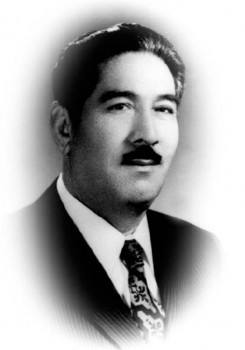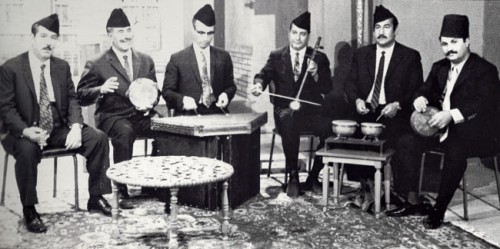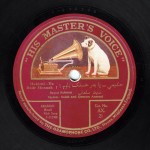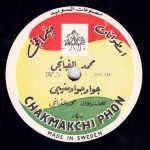The Arab Music Archiving and Research foundation (AMAR), in collaboration with the Sharjah Art Foundation (SAF), presents “Durūb al-Nagham”.
Dear listeners,
Welcome to a new episode of “Durūb al-Nagham”.
Today, we will resume our discussion about the maqām in Iraq with Mr. Ḥusayn al-A‘ẓamī.
We ended our previous episode with the five elements or sections forming the maqām’s musical aspect.
Now… Are there different types of maqām? Do all maqām belong to the same type? Are there original maqām and sub-maqām…etc.?
Let us describe the constituents and forms of the maqām:
There are main maqām and sub-maqām:
- The value of the seven main maqām comes from the uṣūl and from putting together the sections, from the “qiṭa‘ and awṣāl” –described earlier in the maqām banjkāh, i.e. the scale modulations from one scale to another, from one jins to another– many of which were fit together in these main maqām until they reached a major position in the singing of Iraqi maqām, such as the maqām rāst that includes many maḥaṭṭa and is different from any other rāst in the Arab World, its uṣūl in Iraqi maqām being very important and requiring a muṭrib specialized in singing these main maqām… Not just any muṭrib can master these main maqām as his voice must be trained and ready to sing the modulation sequences in the melodic patterns of the seven main maqām (rāst, sikāh, bayyātī, ḥijāz dīwān, ‘ajam ‘ushayrān, nawa…) whose uṣūl are quasi-fixed. There is some leeway within the details between these “qiṭa‘ and awṣāl” –that are fixed in the main maqām– allowing the singer to be creative and to distinguish himself from another singer. So the singer is allowed to perform them differently, i.e. following a melodic pattern that is a little different from the others’… which is normal: my expressions, for example, are surely different from those of another, and constitute the changes marking the difference between one and another.
- Sub-maqām are smaller and allow more freedom for the singer who must perform the fixed parts, but can, in the details of the maqām, take significant initiatives and incorporate personal elements. So, sub-maqām allow much more freedom than main maqām.
On the other hand, there are restrictive and non-restrictive maqām (that we have seen earlier):
- The restrictive correspond to the fixed elements in sub-maqām and in main maqām. The singer can take initiatives but these elements remain fixed. The muṭrib is free to add variations, yet he must abide by these fixed elements.
- The non-restrictive maqām allow total freedom in incorporating other personal “qiṭa‘ and awṣāl”.
Would you give us an example of a fixed maqām and an example of a restrictive maqām (maqām muqayyad)?
The main maqām… For example now, let us notice the taḥrīr… Play a sikāh on a Mi “bekār” (Mi half-flat, or Si half-flat, or Do)… (♩)
The maqām sikāh is among the three maqām accompanied by measured rhythmical music, and the rhythm accompanying the maqām sikāh is one of three maqām, –sikāh, nawa, and manṣūrī, i.e ṣabā– that are accompanied by the 36/4 samāḥ beat…
(♩)
This was the main maqām sikāh.
It is a fixed maqām.
All the principal uṣūl are fixed. The modulations I will perform now are compulsory for every singer.
Let us take the main rāst maqām. Play a rāst on the Do even if it is low, and note the taḥrīr, i.e. the beginning…
(♩)
This was the taḥrīr of the main maqām rāst. The remaining waṣla are fixed.
Let us stop our discussion here and listen to the main maqām rāst that you have just mentioned.
Let us listen to the full maqām as we listened to al-Qubbanjī’s maqām khanabāt in the previous episode.
Yet, this time, the maqām is totally different as there is a deeper relation between the individual performer and the jālghī ensemble accompanying him.
It is performed by Mr. Yūsuf ‘Umar and his jawq, and includes a long instrumental introduction, a dialogue, a brief passage played by the percussions in the middle with a faṣl between the sections of the maqām –like in all maqām, there are no vocals sung with the percussions–, then the basta.
Note that the percussion instruments are different: there is a ṭabla and an ordinary riqq, unlike the instruments in the recordings of the 1932 Congress of Arab Music.
Mr. Yūsuf ‘Umar’s jawq includes first class sanṭūr player Mr. Hāshim al-Rajab who is also a maqām qāri’ with successful achievements in Abbasid codifications added to many works in music research, Mr. Sha‘ūbī (violin), and two unknown percussionists.
Our last remark includes an apology: I digitized this 33 record-side of Mr. Yūsuf ‘Umar 13 years ago and the machine I used was not very advanced: you will notice that the needle is sometimes loose. We fixed what we could. But I take full responsibility for any flaw in this recording that was neither given to us, nor belongs to the collection acquired by AMAR.
If I can find another copy, I promise I will podcast it again on another occasion…
(♩)
Dear listeners,
We have reached the end of today’s episode of “Durūb al-Nagham”.
We will meet again in a new episode to resume our discussion about the maqām ‘irāqī.
We thank Mr. Ḥusayn al-A‘ẓamī.
“Durūb al-Nagham”.
- 221 – Zakariyya Ahmed – 12 (1/9/2022)
- 220 – Zakariyya Ahmed – 11 (1/9/2022)
- 219 – Zakariyya Ahmed – 10 (11/25/2021)
- 218 – Zakariyya Ahmed – 9 (10/26/2021)
- 217 – Zakariyya Ahmed – 8 (9/24/2021)
- 216 – Zakariyya Ahmed – 7 (9/4/2021)
- 215 – Zakariyya Ahmed – 6 (8/28/2021)
- 214 – Zakariyya Ahmed – 5 (8/6/2021)
- 213 – Zakariyya Ahmed – 4 (6/26/2021)
- 212 – Zakariyya Ahmed – 3 (5/27/2021)
- 211 – Zakariyya Ahmed – 2 (5/1/2021)
- 210 – Zakariyya Ahmed – 1 (4/28/2021)
- 209 – W-al-Lāhi lā astaṭī‘u ṣaddak 2 (4/6/2017)
- 208 – W-al-Lāhi lā astaṭī‘u ṣaddak 1 (3/30/2017)
- 207 – Bashraf qarah baṭāq 7 (3/23/2017)




